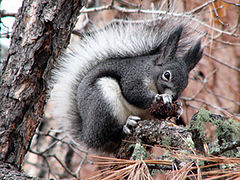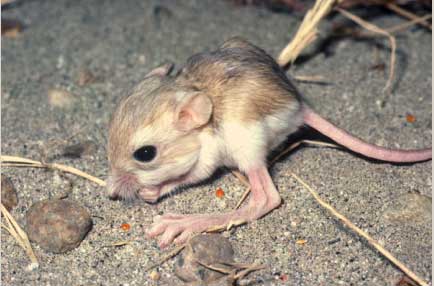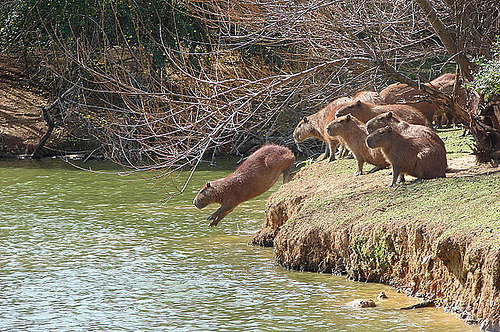For his love and appreciation… its dedicated to Nikunj
(Full video at the bottom)
Starts off in the Central American forests with a nut dropping of a high tree through leaves and etc. Capuchin monkeys having a rather wasteful brekkie. See the nuts real prize is the kernel, which is really hard to get to. The monkeys just scrape off the think fleshy coating and chuck it. Now there is an animal that has the right tools to deal with any nut and that’s the Agouti (rodent). So the Agouti wait for that sound and head for the nut. The front of their teeth got strong enamel while the back has softer dentine which gets worn away, which in turn makes them sharp. Plus they’re rodents so their teeth grow continuously replacing what gets worn away. Rodents are the most successful and numerous of all mammals. 1300 species of rats and mice.

Over to albert squirrels… they use their teeth to also nip of the ends of ponderosa pines coz of the nutritious bark. The only squirrels that can survive where there’s a lot of ponderosa pines. Other squirrels aint all that fussy but acorns are their fav. Dude goes into Oak trees. There’s red oak and white oak. White oak start germinating straight away but red chill till next spring. Their acorn look too similar… only diff is a lil red tint in the … RED oak acorns. Coz the squirrels know this, they immediate eat the white oak ones, and as for the red oak ones they’re stored for winter. Only they are colorblind so they tell the diff by the smell. Thing is some years the red oaks don’t produce so these tasty looking squirrels bury some of the white oaks but only after making a hole in the oak so that way the oak cannot germinate and dude gets some winter food that way.

In the desert it’s a different story coz the seeds are way smaller. David tries to tempt a kangaroo rat out of its burrow… comes out till later. Ahha, so it’s able to transport so many seeds coz it has cheek pouches. Oh and why its called a kangaroo rat is coz the paws you see in the front are really its long back feet. The front ones are hidden away shoveling the seeds into its mouth. Question: How the hell do they manage the shots of inside the burrows, with the animal in there… can’t they see or sense the camera??? Itty-bitty sounds can even wake the kangaroo rat, which sleep during the day and most of the night. This time is woken by a gopher snake. Rat tries stamping its foot to scare the snake. Dunt work. Tries kicking sand in snakes face. VICTORY!!!

Alpine marmots are next… after winter they have to reestablish their grounds. Before the battle starts there’s a lot of tail flagging and calling. If they do battle, it’s the senior male that gets gangsta while wifey looks on and guards the fam burrow. Once the dude wins he marks the area with scent from a gland on his cheeks. They look cute… like miniature bears. Now marmots more into the life partner thing so they stick together for life. David goes on about them chasing away their last years male off spring and this year is all females. HAHAHA daughters are allowed to stay but the mothers constantly beat them up… particularly in spring. So if the daughters are pregnant they have not choice but to abort. It will be explained soon. There’s peace by mid-summer and more little ones emerge from the maternity burrow. Usually 4-6 in a litter. Summer doesn’t last long so they feed as much as they can while they can. The fattened up babies look so fit!!! In autumn they start collecting hay to line their burrow for decent sleep in winter. In winter their body temp is about 2 degrees C and their heart beats only 2-3 times a minute. Hibernation… they all snuggle to save heat, kiddos in the middle. See now they can’t keep more than one litter warm enough to survive winter, which is why mama unleashed drama on her daughters.

Over to the beaver in North America. David calls them engineers… then shows an amazing shot of a dam the family of beavers built. Then the shot moves up to the lake. What’s amazing is that the beavers created the lake by making the dam. It’s so important to them that they start repairs pronto when their hearing alerts them. You see them fetching mud and logs and twigs etc. What I’m impressed about is their accuracy of the height of the damn horizontally. There’s never more than a 5inch difference in height. Flooding the area helps them swim around coz they’re more at home in water… it also leads them to their main source of food. So like they make channels to swim to places. There’s a shot of a beaver finding a fallen tree, peeling bark with its teeth. It’s still in the shallow bits of water but that’s safety incase a bear or mountain lion etc come around. The network of channels also enables them to ferry back branches etc. Wicked shot where the beaver dives down with the branch and you see it stuffing the branch into the mud of the damn. This is meant to be the beavers fridge. Beavers are extra busy in autumn with the stocking of their fridge. Oh I get it, the mud is the fridge and the branches are the food. Beaver have a lodge/fortress that even bears cant break into. The only entrance is a tunnel, which open underwater. So when they’re alarmed you know where they’re gonna take refuge. David rows by to scare them and reveal their alarm signal. Basically before it dives in it slaps its flat tail on the water surface. Coz they can stay underwater 5-15 minutes they can go straight to their lodge without having to come up again. Most lodges have at least 2 different entrances. Winter comes and unlike marmots, beavers will be active through out the winter. The film crew installed a couple of infrared cameras in the lodge when the beavers were away. Beaver brings a branch from the fridge to feed the fam. So cool man, the lodge has a kinda chimney. You can see the hot air coming out in steam from the vent. New discovery: There are muskrats in the lodge too. Do the beavers know? Can they make it out in pitch black? They leave the lodge and come back with a few reeds. David thinks perhaps they’re renting. The beavers even share their food with the muskrats. That’s all about the lodge coz beaver covered the camera.

Wow, apparently the camera is called a starlight camera… and boy do you see them stars loud and proud. Anyway moving on to the African crested porcupine… most of the time its spines are flat, guess they’re half erect coz its not too happy with David being so close. Porcupines like eating roots and tubers but have to travel long distance to get their grub. So they have to be ready for all kinda gangsters. Lol Young leopard spots it, David says its never experienced a porcupine before. Never seen a big cat act like a playful curious cat before. Porcupine’s so confident its not moved or anything… goes on doing its thang. Guess that’s why young leopard didn’t try anything.

Ground squirrels look so cute. They build their burrows close to each other coz they’re hardly trees around or water. Kinda like a neighborhood watch thing. Paras note: Sounds like my fellow vanias in ORC. A couple of adults keep watch while the lil ones feed. Only the females care for the young and nearly all related to one another. So the mothers take care of nephews and nieces as they would their own. When the guards see some danger they have special warnings. Quick repeated trills means possible danger but evasive action not required. While longer, slower, lower calls means… run for it! Even running for it they look cute but they confused bobcat classic.
Amazon #ads


Its home time baby! Naked mole rats in Kenya! Mostly you’ll only get a chance to see mud out of their holes. They do all their stuff underground. Whoa… they’re ugly. Lips behind their long curvy incisors to stop mud getting in. Pale and wrinkly! Reminds one of pigs. Anyway so they have a central chamber where colonies gather and babies are kept… and this chamber stretches out to networks of tunnels. Hmm all these babies are produced by one big female. The founder of the colony. Paras: She must be hot. So no others can breed again so long as the mothers alive. Their job is to tunnel and search for tubers and roots. Hehehe while moving along the tunnels if they meet head to head with another… they sniff each other… see who’s older… then older ones steps over to pass. Ugh… seriously nasty looking. Picture testicle skin in albino shades. LMAO… shot of one reversing and bumping into another. Then David mentions that they’re blind so they’re as happy to move around backwards as they are forwards. Now coz they’re blind they have to guess and dig and hope to bump into a tuber… which is why there’s dozens of workers on the job. If they do find a decent tuber it will last them about 12 weeks. So these are the only mammals that have adopted the bees and ants setup of having one main queen mother.

Harvest mice have nests in reeds or tall grasses. Give birth to litters of up to 8 babies, which mature in just a few weeks. And they produce about 3 litters so about 30 young in a single season. Youngsters leave the nest in only 2 weeks and start searching for food by themselves. But not nearly as agile as the parents and sometimes not sure where they can tread. They were called harvest mice coz you’d only see them when crops were being gathered.

After the harvest another type of mouse enjoys the leftovers. The common house mice. The most prolific mice. Wow, the female is capable of giving birth at 5 weeks old and if/when possible… give birth every month. If the grain supply is finished they head for the houses and that’s when you see how many there are. All jumping around and stuff. Oh man, now can I describe this one… remember the end of The Mummy? Where all these scarabs just overflow the joint? Just replace the scarabs with mice. Now just as they rose, as soon as the grain is over their numbers will fall just as fast.

Moving on to the patagonian cavies or maras. (Spelling). Look like horse faced rabbits or something. In their case they have only one guard keeping watch. The young feed in the communal crèche, which in this case is a hole, which was dug initially by burrowing owls. Dig that! The maras have just enlarged it. Now the guard takes care of others babies too but the mother will only give her milk to her own. The adults are not related so changing the guard sometimes gets tense. First a few shots of adults chasing each other. Then a shot of an owl chilling in its dip right in the middle of the action, looking on. First owl I’ve seen not having proper round eyes. This ones got eyes of the serious blue dude in… um… the moppets. It does okay! Now coz they have longer legs they’re not good at digging which is why they prefer stealing holes from the owls. A plother (bird thing/spelling) warns them of approaching danger. The babies luckily have a hole to go to. But its not big enough for the adults. All they can do is run.

Another kinda rodent that gathers in vast numbers to graze are the biggest rodents in the world… the capybara in South America. Like the mara they’re related to guinea pigs. But these ones use their teeth to crop grass. When they want they can gallop as fast as a small horse. Land or water… don’t matter, they’re equally at home. In the herds each fam sticks together. From grandparents to grandchildren. And one large dominant males that marks his territory with a gland on top of his nose. Dude chases away a male that comes close to his fam especially if they come too close to his females. BOUT! Plus a wicked shot of 3 others watching and cheering. What makes them at home in water is the oily fur, partially webbed feet, and the eyes and nostrils are on top of their heads. A reason why the scent glands, which is usually under the cheeks, has migrated to the top of the nose.
Ends by comparing the maras to antelopes and capybara as hippos.
1. A Winning Design | 2. Insect Hunters | 3. Plant Predators
4. Chisellers | 5. Meat Eaters | 6. The Opportunists
7. Return to the Water | 8. Life in the Trees | 9. The Social Climbers
10. Food for Thought




